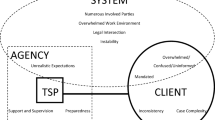Abstract
The purpose of this exploratory focus group study was to examine child welfare professionals’ (n = 22) experiences with and perspectives towards working with fathers. The six themes that emerged from the thematic analysis contrasted sharply with earlier research findings and indicated that child welfare professionals skillfully engage fathers and that some fathers trust the system and are motivated to be involved. The findings revealed insights about foster fathers and working with foster parents. Unique regional issues also emerged as a factor that affect fathers and families. Recommendations for designing training, especially in areas with limited fatherhood specific services are provided.
Similar content being viewed by others
References
American Humane Association (AHA). Family group decision making: Various approaches and models to engage the family group in child welfare decision making. Retrieved from http://www.americanhumane.org/assets/docs/protecting-children/pc-fgdm-quickreference-guide.pdf. Accessed 16 August 2010.
Bellamy, J. L. (2009). A national study of male involvement among families in contact with the child welfare system. Child Maltreatment, 14, 255–262.
Berger, L. M., Paxson, C., & Waldfogel, J. (2009). Mothers, men, and child protective services involvement. Child Maltreatment, 14(3), 263–276.
Cabrera, N. J. (2010). Father involvement and public policies. In M. E. Lamb (Ed.), The role of the father in child development (5th ed., pp. 517–550). Hoboken: Wiley.
Cabrera, N. J., & Peters, E. (2000). Public policies and father involvement. Marriage and Family Review, 29(4), 295–314.
Cardoso, J. B., Gomez, R. J., & Padilla, Y. C. (2009). What happens when family resources are across international boundaries? An exploratory study on kinship placement in Mexican immigrant families. Child Welfare, 88(6), 67–84.
Child Welfare Information Gateway (CWIG). (2010). Determining the best interests of the child: Summary of state laws. Retrieved from http://www.childwelfare.gov/systemwide/laws_policies/statutes/best_interest.cfm. Accessed 16 August 2010.
Cooper Hodgson, H. S. (1929). The education of the father: The case for its inclusion in a maternity and child welfare scheme. The Journal of the Royal Society for the Promotion of Health, 50, 593–596.
Daniel, B., & Taylor, J. (1999). The rhetoric versus the reality: A critical perspective on practice with fathers in child care and protection work. Child and Family Social Work, 4, 209–220.
Dubowitz, H. (2009). Commentary on fathers and children and maltreatment: Relationships matter most. Child Maltreatment, 14(3), 291–293.
English, D. J., Brummel, S., & Martens, P. (2009). Fatherhood in the child welfare system: Evaluation of a pilot project to improve father involvement. Journal of Public Child Welfare, 3, 213–234.
Fanshel, D. (1982). On the road to permanency. An expanded data base for service to children in foster care. New York: Child Welfare League of America.
Franck, E. J. (2001). Outreach to birthfathers of children in out-of-home care. Child Welfare, 80(3), 381–399.
Huebner, R. A., Werner, M., Hartwig, S., White, S., & Shewa, D. (2008). Engaging fathers: Needs satisfaction in child protective services. Administration in Social Work, 32(2), 87–103.
Ivey, A. (1971). Microcounseling: Innovations in interviewing training. Springfield: Charles C. Thomas.
Jaffe, E. D. (1983). Fathers and child welfare services: The forgotten client? In M. Lamb & A. Sagi (Eds.), Fatherhood and family policy (pp. 129–137). Hillside: Lawrence Erlbaum.
Kirsh, S., & Maidman, F. (1984). Child welfare problems and practice: An ecological approach. In F. Maidman & S. Kirsh (Eds.), Child welfare: A sourcebook of knowledge and practice (pp. 1–14). New York: Child Welfare League of America.
Lamb, M. E. (Ed.). (2010). The role of the father in child development (5th ed.). Hoboken: Wiley.
Lipsky, M. (1980). Street-level bureaucracy: Dilemmas of the individual in public services. New York: Russell Sage.
Malm, K., Murray, J., & Geen, R. (2006). What about the dads? Child welfare agencies’ efforts to identify, locate and involve nonresident fathers. Washington, DC: U.S. Department of Health and Human Services, Office of the Assistant Secretary for Planning and Evaluation.
Malm, K. E., & Zielewski, E. H. (2009). Nonresident father support and reunification outcomes for children in foster care. Children and Youth Services Review, 31, 1010–1018.
O’Donnell, J. M. (1999). Involvement of African American fathers in kinship foster care services. Social Work, 44(5), 428–441.
O’Donnell, J. M. (2001). Paternal involvement in kinship foster care services in one father and multiple father families. Child Welfare, 80(4), 453–479.
O’Donnell, J. M., Johnson, W. E., D’Aunno, L. E., & Thorton, H. L. (2005). Fathers in child welfare: Caseworkers’ perspectives. Child Welfare, 84(3), 387–414.
Polansky, N. A., De Saix, C., & Sharline, S. A. (1972). Child neglect: Understanding and reaching the parent. New York: Child Welfare League of America.
Rossi, P. H., Schuerman, J., & Budde, S. (1999). Understanding decisions about child maltreatment. Evaluation Review, 23(6), 579–599.
Saldaña, J. (2009). The coding manual for qualitative researchers. Thousand Oaks: Sage.
Sonenstein, F., Malm, K., & Billing, A. (2002). Study of fathers’ involvement in permanency planning and child welfare casework. Washington, DC: US Department of Health and Human Services. Retrieved from http://aspe.hhs.gov/hsp/cw-dads02/. Accessed 13 May 2004.
Stone, N. M., & Stone, S. F. (1983). The predictions of successful foster placement. Social Casework: The Journal of Contemporary Social Work, 64(1), 11–17.
US Department of Health and Human Services (DHHS). (2007). Non-resident fathers, paternal kin and the child welfare system. Retrieved from http://www.abanet.org/child/fathers/QICNRFLiteratureReview.pdf. Accessed 14 July 2008.
US Department of Health and Human Services (DHHS). (2010). Child and Family Service Reviews. Retrieved from http://www.childwelfare.gov/management/reform/cfsr/. Accessed 16 August 2010.
Acknowledgments
The author wishes that thank Susan Mears, Ph.D. for her assistance with the data analysis and Naomi Suskind, MSW for research team assistance. This work was supported in part by a grant from the University of Nevada, Reno, Junior Faculty Research Grant Fund. This support does not necessarily imply endorsement by the university of research conclusions.
Author information
Authors and Affiliations
Corresponding author
Rights and permissions
About this article
Cite this article
Saleh, M.F. Child Welfare Professionals’ Experiences in Engaging Fathers in Services. Child Adolesc Soc Work J 30, 119–137 (2013). https://doi.org/10.1007/s10560-012-0282-0
Published:
Issue Date:
DOI: https://doi.org/10.1007/s10560-012-0282-0




